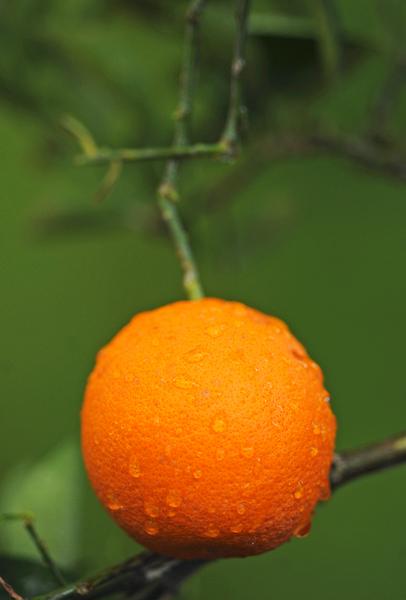http://www.denverpost.com/ci_8811304?source=rss
Pucker up and enjoy citrus' delights
By Colleen Smith
Special to The Denver Post
Posted: 04/11/2008 01:00:00 AM MDT
 A valencia orange bears fruit at Tagawa Gardens.
A valencia orange bears fruit at Tagawa Gardens.
( RJ Sangosti, The Denver Post )
In aromatherapy, citrus stimulates joy. In horticulture? The same thing.
Meyer lemons, Mexican limes, Satsuma mandarin oranges, kumquats: Just reciting the names of these cheerily colored citrus fruits can make one's mouth pucker. Citrus fruits are sour, yet the plants make sweet container specimens with glossy leaves and fragrant blossoms.
And during Colorado's cold winters, you can invite potted citrus trees indoors to spend the winter near a window with a southern exposure, then reintroduce them to the outdoors each spring.
Citrus plants are pricey. At Tagawa Gardens, the smallest plants about 18 inches tall average about $20 each. Patio trees range in height from 3 to 4 feet and cost $60-$80, says Dee Beckman, a tropical horticulturist at the garden center.
That's not exactly chump change, so you'll want to protect your investment. Following general guidelines will ensure that your citrus plant lives for many seasons. In fact, Beckman grew up with a grapefruit tree her parents planted from a seed.
"They still have it. It took about 20 years to get one grapefruit, and now they get about six per year," Beckman said, "but it's a beautiful plant, and the smell of those leaves!"
Note to the frugal and adventurous gardener: Growing citrus from seeds isn't the best idea if you eventually want blossoms and fruit. "Sunkist now breeds them so they won't fruit or flower," Beckman said.
Citrus trees can set their blossoms and bear fruit concurrently. And when you purchase a citrus tree from a greenhouse, if all goes well, you won't have to wait nearly as long as Beckman's parents did for grapefruit.
Beckman has received shipments of a wide variety of citrus already blooming and bearing fruit. This year, because of a quarantine of Florida citrus, all citrus trees come from California. Beckman's personal favorite is "Pink Lemonade" a variegated pink lemon.
Denver Botanic Gardens horticulturist Luke Tembrock tends a pumelo and a lime tree, and he's also a fan of an oddly shaped, though delicious, citrus fruit known as "Buddha's Hand."
Tembrock cautions that when buying a young citrus tree, inquire whether the nursery uses systemic pesticides.
"They've done a lot to make systemic pesticides less toxic and have banned a lot of them, but if they use them, don't eat the fruit off the tree for six months to one year," he said.
For Colorado gardeners growing citrus in containers, Tembrock and Beckman offered these tips:
Container: Make sure the pot has a drainage hole.
Soil: To assist drainage, blend potting soil with up to 25 percent gravel.
Light: "Citrus need at least four to six hours of full sun to even think about flowering," Beckman said.
Watering: Keep soil moist, not soggy. Mist plants with a hose or group with other plants to boost humidity.
Fertilizing: Tembrock recommends a standard fertilizer with additional phosphorous or adding bone meal.
Diseases and pests: Citrus are susceptible to a number of diseases and pests. Tembrock warns against scale and mealy bugs, particularly when plants are indoors. Watch for telltale signs of clear, sticky substance on the leaves or deposits of white, cottony substance. When treating disease or pests, beware of chemicals you're putting on plants if you plan to eat its fruits.
Pruning: "Citrus wood is super dense," Tembrock said, noting the need for sharp pruners and saws. Beckman advised cutting back plants by at least one-third before bringing them inside for winter. Pruning helps plants adjust to lower light, stimulates growth and promotes branching.
Overwintering: Bring plants indoors before temperatures dip down around 40 degrees F. Situate them close to a window with a southern exposure. "A west window won't do," Beckman said. "They pout in winter and drop a lot of leaves, but just keep them alive until you can get them outside again."
Reintroducing plants to outdoors after winter: Drastic changes in temperature and humidity can shock plants, and a sudden increase in radiation can burn leaves. Ideally, once evening temperatures remain above 40 degrees, move plants to a sheltered area like a porch or covered patio sheltered from sun and wind. Gradually reintroduce plants to full sun.
And if your garden hands you lemons, make lemonade.
Colleen Smith writes from and gardens in Denver. Her lemon and lime trees in containers purchased last spring not only survived winter indoors, but put on new growth, blossomed and bore fruit. 









